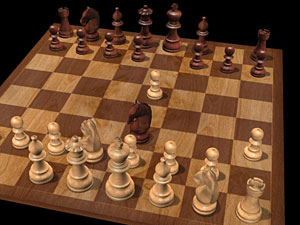Chess Explorations (99)
By Edward Winter
One of the most famous games in chess literature is 1 d4 Nf6 2 Nd2 e5
3 dxe5 Ng4 4 h3 Ne3 5 White resigns. When it appeared on page 8 of Schachmethodik
by S. Tartakower (Berlin, 1928 and 1929) it was described as ‘the shortest
tournament game of all time’:

If Tartakower could be proved right, that would be the end of the matter,
but no such game has been found in the records of 1924, and all manner of
other ‘information’ has been seen in print. For example, in his introduction
to Chess Tactics (Ramsbury, 1984) Paul Littlewood called it ‘the
shortest match game known in chess literature – Gibaud-Lazard, Paris, 1927’.
Richter’s Kombinationen (various editions) dated it 1935.
A further complication is that a similar but longer game (1 d4 d5 2 Nf3
Bg4 3 Ne5 Nf6 4 Nxg4 Nxg4 5 Nd2 e5 6 h3 Ne3 7 White resigns) had been published
pre-1924. From page 221 of the June 1921 BCM:

This text appeared in the ‘Colonial and Foreign News’ section, of which
the Editor was apparently P.W. Sergeant.
In C.N. 7904 Dominique Thimognier (Fondettes, France) gave a cutting from
page 12 of the Feuille d’Avis de Lausanne, 24 June 1933 (chess column
by André Chéron):
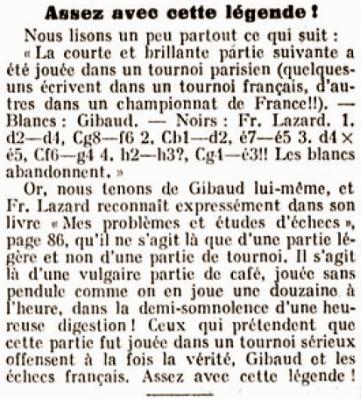
In short, both Gibaud and Lazard had stated that it was merely an off-hand
game and had not happened in a tournament. C.N. 7927 gave, courtesy of Alain
Biénabe (Bordeaux, France), the relevant page of Lazard’s book Mes problèmes
et études d’échecs (Paris, 1929):
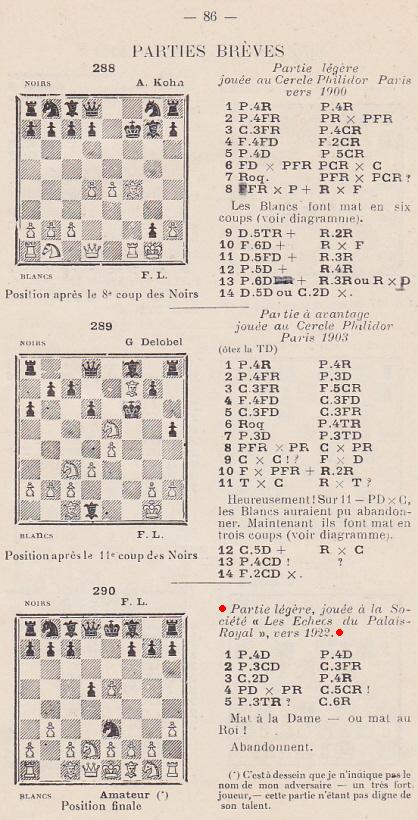
As mentioned on page 351 of Kings, Commoners and Knaves, a flat
denial from Gibaud came on page 420 of CHESS, 14 July 1937:
‘Monsieur Gibaud asks us to correct a mistake made by the author of Curious
Chess Facts [Irving Chernev] and quoted by us last month. He never
lost any tournament game in four moves. Searching his memory he recalls
a “skittles” he once played against Lazard, a game of the most light-hearted
variety, in which, his attention momentarily distracted by the arrival
of his friend Muffang, he played a move which allowed a combination of
this genre – but certainly not four moves after the commencement of the
game. Rumour, he said, must have woven strange tales about this game,
coupling it perhaps with the theoretical illustration Znosko-Borovsky
gives on page 24 of his Comment on devient brillant joueur d’échecs
(Paris, 1935).’
Notwithstanding all the above contradictions, Irving Chernev maintained
that the moves 1 d4 Nf6 2 Nd2 e5 3 dxe5 Ng4 4 h3 Ne3 5 White resigns had
indeed occurred in a tournament in Paris in 1924 between Gibaud and Lazard.
It was the opening game in two of his books, 1000 Best Short Games of
Chess (New York, 1955) and Wonders and Curiosities of Chess (New
York, 1974). On page 30 of the Summer 1955 issue of the Chess Reader
Chernev indicated that he considered that Tartakower ‘should be a fairly
good authority’, given the game’s appearance in Schachmethodik. However,
on the basis of documentation now known (and particularly the BCM
report reproduced above) the most likely conclusion is that in Paris in
1920 Gibaud and Lazard played a quick, off-hand game which went 1 d4 d5
2 Nf3 Bg4 3 Ne5 Nf6 4 Nxg4 Nxg4 5 Nd2 e5 6 h3 Ne3 7 White resigns. Can anything
further be discovered?
Chernev being a highly popular writer (and, in many respects, rightly so),
his version of the Gibaud v Lazard game has tended to predominate. As is
well known, many chess writers freely copy from secondary sources without
bothering to make an independent check. If readers care to make a search
for ‘1000 Best Short Games of Chess’ on the Chess Notes website they
will find many examples of faulty game-scores and other incorrect information
in that book which have been unquestioningly copied in other publications.
Of course, such unquestioning copying is not plagiarism, the latter being
a particularly sordid corner of the chess world which will never be eradicated
without maximum public exposure. The latest instance is the discovery by
Justin Horton that material from the first volume of Kasparov’s My Great
Predecessors series has been misappropriated by Raymond Keene in The
Spectator.
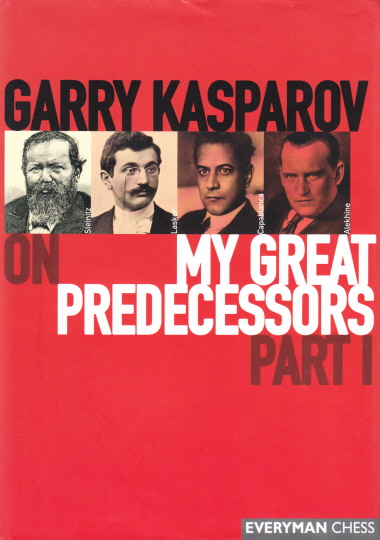
For further details, see C.N.
8099.
All
ChessBase articles by Edward Winter
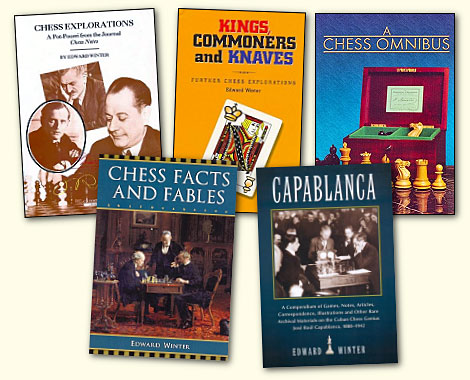
Edward Winter is the editor of Chess
Notes, which was founded in January 1982 as "a forum for aficionados
to discuss all matters relating to the Royal Pastime". Since then, about
8,100 items have been published, and the series has resulted in four books
by Winter: Chess
Explorations (1996), Kings,
Commoners and Knaves (1999), A
Chess Omnibus (2003) and Chess
Facts and Fables (2006). He is also the author of a monograph on
Capablanca (1989). In 2011 a paperback
edition was issued.
Chess Notes is well known for its historical research, and anyone browsing
in its archives
will find a wealth of unknown games, accounts of historical mysteries, quotes
and quips, and other material of every kind imaginable. Correspondents from
around the world contribute items, and they include not only "ordinary readers"
but also some eminent historians – and, indeed, some eminent masters. Chess
Notes is located at the Chess
History Center. Signed copies of Edward Winter's publications
are currently
available.
